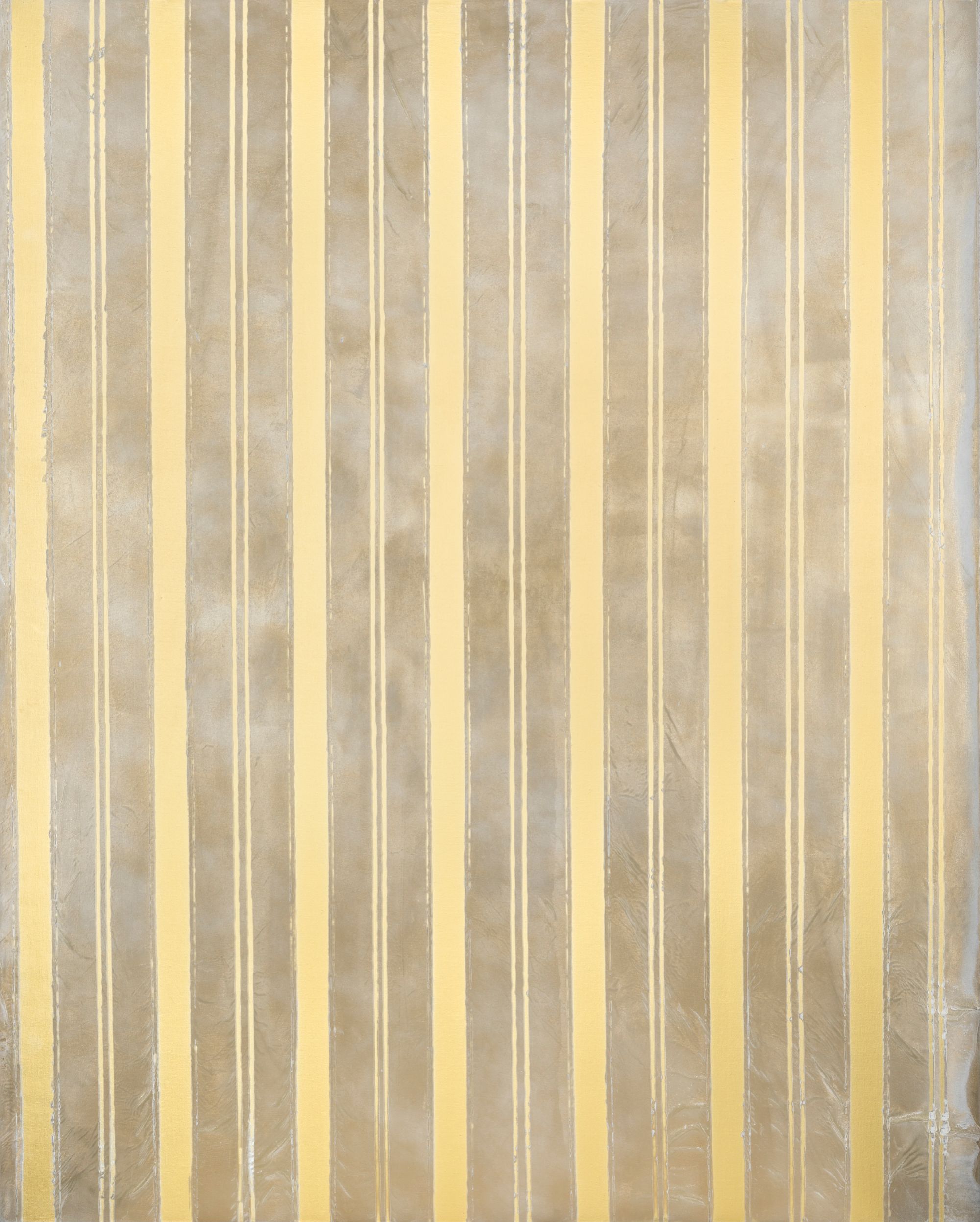

7Ο◆
Rudolf Stingel
Untitled
Full-Cataloguing
Sparking a delicate interplay between the luminous transparency of a reflective mirror and the muted density of opaque velvet, Untitled espouses a dazzling complexity. Galvanised by a gleaming and reflective surface, the present work amalgamates a sense of the decorative with a geometrically linear pattern. The shimmering and resplendent golden hues seduce, causing the eye to dance across the astral and ethereal canvas, a notion at the very core of Stingel’s practice. As Chrissie Iles has described, ‘Stingel’s approach to surface is always paradoxical…he is…deeply interested in its seductive, tactile quality' (Chrissie Iles, ‘Surface Tension’ in Rudolf Stingel, exh. cat., Museum of Contemporary Art, Chicago, 2007, p. 24). Returning time and again to explore the conceptual parameters of gilded gold-leaf pigment, Stingel tests the limits of colour, subsuming its inferences of royal finery and brocade alongside suggestions of profound textural depth.
Arriving in New York in the late 1980s, Stingel rebelled against the existing minimalist and neo-expressionist tendencies, instead pioneering an innovative approach to painting through the production of a silver monochrome series. In 1989 Stingel released his seminal Instructions: a limited edition art book outlining the complex process by which his enamel works could be replicated. By democratically classifying his technique, Stingel demystifies his process, subverting notions of authorial genius in favour of a sense of industrial manufacture and mechanised labour similar to that of Andy Warhol’s Factory. Stingel’s interest in the metallic connects to European monochromists such as Yves Klein, whose enigmatic style and extensive investigation into the suspension of pigment injected the art world with sparkle and vitality.
Stingel’s debut show at the Daniel Newburg Gallery, New York, in 1991 set the tone of his daringly rebellious oeuvre. Covering the gallery’s entire floor with a vibrant orange carpet, visitors were invited to engage and absorb Stingel’s installation. Describing the exhibition, The New York Times art critic Roberta Smith famously noted how Stingel’s works were ’profoundly, disturbingly, subversively optical’ (Roberta Smith, ‘DIY Art: Walk on It, Write on It, Stroke It’, The New York Times, 29 June 2007, online). Stingel returned to this conceptual framework for his major mid-career retrospective at the Museum of Contemporary Art in Chicago and The Whitney Museum of American Art in New York. Covering large sections of each museum’s galleries in aluminium foil, visitors were invited to touch, write on and interact with the work, forever imprinting their mark and contributing to the art work as a whole.
Alluding to opulence and luxury, the golden sheen emanating from Untitled offers a radiance of glorious intensity. With a supreme vibrancy, material and colour are at once the same, and automatically imbued with a sense of inherent importance and value. Simultaneously a masterpiece and a decorative, perhaps domestic object, the vertical stripes plastered upon the present work call to mind the decadent Italian Baroque and French Rococo interiors once privately admired by the European bourgeois. Furthermore, Untitled has strong aesthetic affinities to visionary painters Frank Stella and Agnes Martin, both mediators of Abstract Expressionism and Minimalism. Accordingly, Roberta Smith comments, ‘[Stingel] combines a love of painting with the postmodern suspicion of it, and often achieves a near-perfect balance between the visual and the conceptual’ (ibid.)
As such, Untitled disrupts the viewer’s understanding and experience of the art object. The present work’s thought-provoking beauty thus challenges every assumption or theory about the medium of painting. With Untitled, as in the rest of his highly conceptual works, Stingel ‘demonstrates an acute awareness of the aspirations, failures and challenges to modernist painting, while at the same time expressing a sincere belief in painting itself, focussing on formal characteristics including colour, gesture, composition, and, most importantly, surface’ (Rudolf Stingel, exh. cat., Museum of Contemporary Art, Chicago and The Whitney Museum of American Art, New York, 2008, p. 112). Overturning hierarchies and pushing the boundaries of abstraction, materiality and aesthetic experience, Stingel ‘redefine[s] what painting can be, what it has been, what it is’ (Francesco Bonami cited in Michelle Grabner, ‘Rudolf Stingel’, Frieze, April 2007, issue 106, online).
By disrupting painting's assumption of material, process, and placement, Stingel bursts open the conventions of painting, forever impacting our understanding of contemporary art. Standing at the outset of one of the twenty first century’s most profoundly original and individual attempts of transcending the conventional conceptions of traditional painting, Untitled typifies Stingel’s enigmatic style and inimitable creative spirit.
Rudolf Stingel
Italian | 1956Rudolf Stingel came to prominence in the late 1980s for his insistence on the conceptual act of painting in a context in which it had been famously declared dead. Despite the prevailing minimalist and conceptual narrative of the time, the Italian-born artist sought to confront the fundamental aspirations and failures of Modernist painting through the very medium of painting itself. While his works do not always conform to the traditional definitions of painting, their attention to surface, space, color and image provide new and expanded ways of thinking about the process and "idea" of painting. Central to his multifarious and prolific oeuvre is an examination of the passage of time and the probing of the fundamental questions of authenticity, meaning, hierarchy, authorship and context by dislocating painting both internally and in time and space. Stingel is best known for his wall-to-wall installations, constructed of fabric or malleable Celotex sheets, as well as his seemingly more traditional oil-on-canvas paintings.